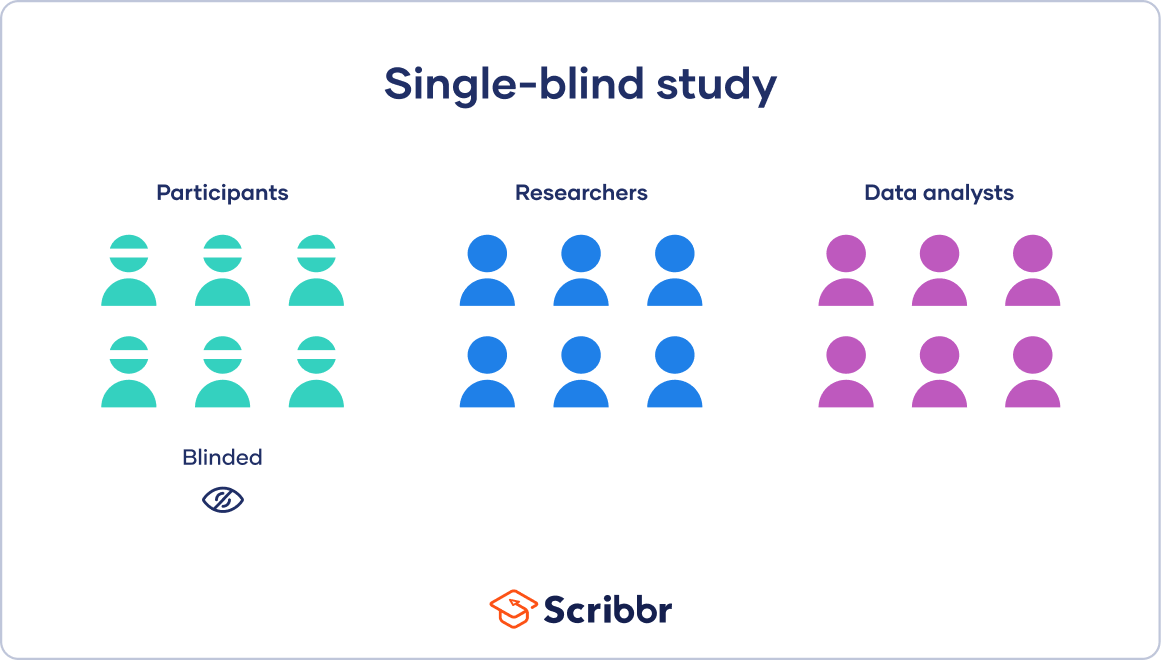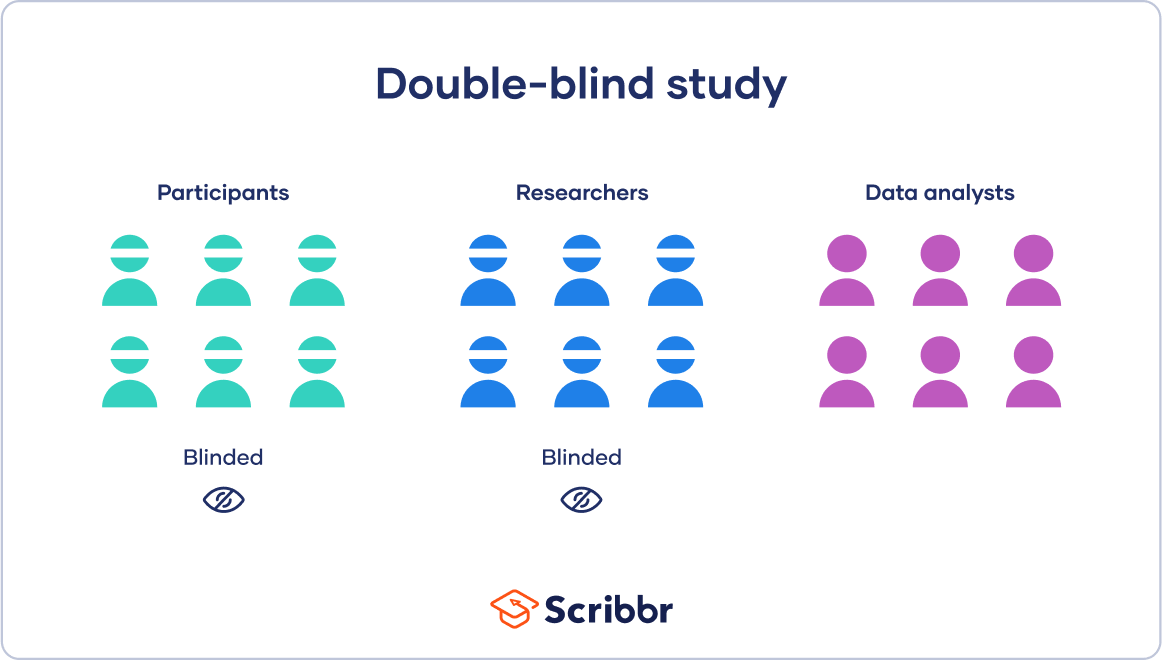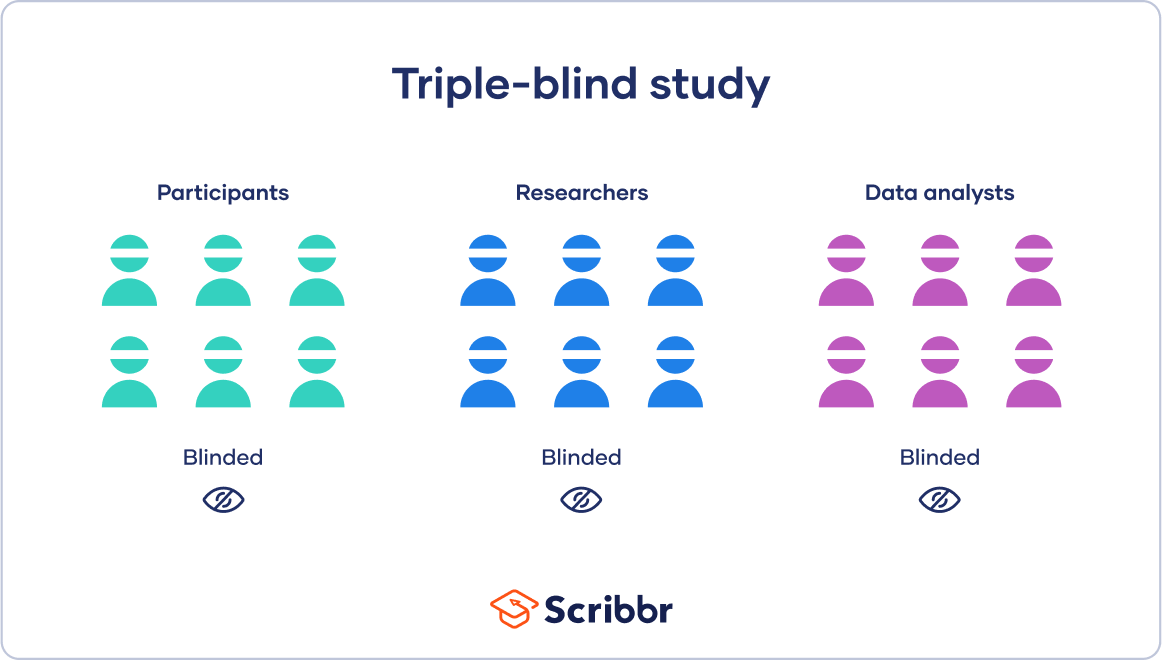Single, Double & Triple Blind Study | Definition & Examples
In experimental research, subjects are randomly assigned to either a treatment or control group. A double-blind study withholds each subject’s group assignment from both the participant and the researcher performing the experiment.
If participants know which group they are assigned to, there is a risk that they might change their behavior in a way that would influence the results. This can lead to a few types of research bias, particularly social desirability bias, self-selection bias, Hawthorne effect, or other demand characteristics.
Conversely, if researchers know which group a participant is assigned to, they might act in a way that reveals the assignment or directly influences the results. This can also lead to biases, particularly observer bias.
Double blinding guards against these risks, ensuring that any difference between the groups can be attributed to the treatment.
Different types of blinding
Blinding means withholding which group each participant has been assigned to. Studies may use single-, double- or triple-blinding.
Single-blinding occurs in many different kinds of studies, but double- and triple-blinding are mainly used in medical research.
Single blinding
If participants know whether they were assigned to the treatment or control group, they might modify their behavior as a result, potentially changing their eventual outcome.
In a single-blind experiment, participants do not know which group they have been placed in until after the experiment has finished.
If participants in the control group realize they have received a fake vaccine and are not protected against the flu, they might modify their behavior in ways that lower their chances of becoming sick – frequently washing their hands, avoiding crowded areas, etc. This behavior could narrow the gap in sickness rates between the control group and the treatment group, thus making the vaccine seem less effective than it really is.
To prevent such an outcome, in a single-blind study, you hide from the participants which vaccine – real or fake – each of them received.
Double-blinding
When the researchers administering the experimental treatment are aware of each participant’s group assignment, they may inadvertently treat those in the control group differently from those in the treatment group. This could reveal to participants their group assignment, or even directly influence the outcome itself.
In double-blind experiments, the group assignment is hidden from both the participant and the person administering the experiment.
If these experimenters knew which vaccines were real and which were fake, they might accidentally reveal this information to the participants, thus influencing their behavior and indirectly the results.
They could even directly influence the results. For instance, if experimenters expect the vaccine to result in lower levels of flu symptoms, they might accidentally measure symptoms incorrectly, thus making the vaccine appear more effective than it really is.
To avoid this, you hide group assignments from both the participants and the experimenters giving the vaccines – a double-blind study.
Triple-blinding
Although rarely implemented, triple-blind studies occur when group assignment is hidden not only from participants and administrators, but also from those tasked with analyzing the data after the experiment has concluded.
Researchers may expect a certain outcome and analyze the data in different ways until they arrive at the outcome they expected, even if it is merely a result of chance.
To achieve triple blinding, you assign each participant to group 1 or group 2, but do not inform the data analysts which number represents which group.
Here's why students love Scribbr's proofreading services
Importance of blinding
Blinding helps ensure a study’s internal validity, or the extent to which you can be confident any link you find in your study is a true cause-and-effect relationship.
Since non-blinded studies can result in participants modifying their behavior or researchers finding effects that do not really exist, blinding is an important tool to avoid research bias in all types of scientific research.
Risk of unblinding
Unblinding occurs when researchers have blinded participants or experimenters, but they become aware of who received which treatment before the experiment has ended.
This may result in the same outcomes as would have occurred without any blinding.
You randomly assign some students to the new program (the treatment group), while others are instructed with a standard program (the control group). You use single blinding: you do not inform students whether they are receiving the new instruction program or the standard one.
If students become aware of which program they have been assigned to – for example, by talking to previous students about the content of the program – they may change their behavior. Students in the control group might work harder on their reading skills to make up for not receiving the new program, or conversely to put in less effort instead since they might believe the other students will do better than them anyway.
Thus, the results of your study could be invalid unless you prevent any unblinding.
Inability to blind
Double or triple blinding is often not possible. While medical experiments can usually use a placebo or fake treatment for blinding, in other types of research, the treatment sometimes cannot be disguised from either the participant or the experimenter. For example, many treatments that physical therapists perform cannot be faked.
In such cases, you must rely on other methods to reduce bias.
- Running a single rather than double- or triple-blind study. Sometimes, although you might not be able to hide what each subject receives, you can still prevent them from knowing whether they are in the treatment or control group. Single blinding is particularly useful in non-medical studies where you cannot use a placebo in the control group.
- Relying on objective measures that participants and experimenters have less control over rather than subjective ones, like measuring fever rather than self-reported pain. This should reduce the possibility that participants or experimenters could influence the results.
- Pre-registering data analysis techniques. This will prevent researchers from trying different measures of analysis until they arrive at the answer they’re expecting.
Other interesting articles
If you want to know more about statistics, methodology, or research bias, make sure to check out some of our other articles with explanations and examples.
Statistics
Methodology
Frequently asked questions about double-blind studies
- What is blinding in research?
-
Blinding means hiding who is assigned to the treatment group and who is assigned to the control group in an experiment.
- What is the difference between single-blind, double-blind and triple-blind studies?
-
- In a single-blind study, only the participants are blinded.
- In a double-blind study, both participants and experimenters are blinded.
- In a triple-blind study, the assignment is hidden not only from participants and experimenters, but also from the researchers analyzing the data.
- Why is blinding important in research?
-
Blinding is important to reduce research bias (e.g., observer bias, demand characteristics) and ensure a study’s internal validity.
If participants know whether they are in a control or treatment group, they may adjust their behavior in ways that affect the outcome that researchers are trying to measure. If the people administering the treatment are aware of group assignment, they may treat participants differently and thus directly or indirectly influence the final results.
Cite this Scribbr article
If you want to cite this source, you can copy and paste the citation or click the “Cite this Scribbr article” button to automatically add the citation to our free Citation Generator.
Thomas, L. (2023, June 22). Single, Double & Triple Blind Study | Definition & Examples. Scribbr. Retrieved April 26, 2024, from https://www.scribbr.com/methodology/double-blind-study/



